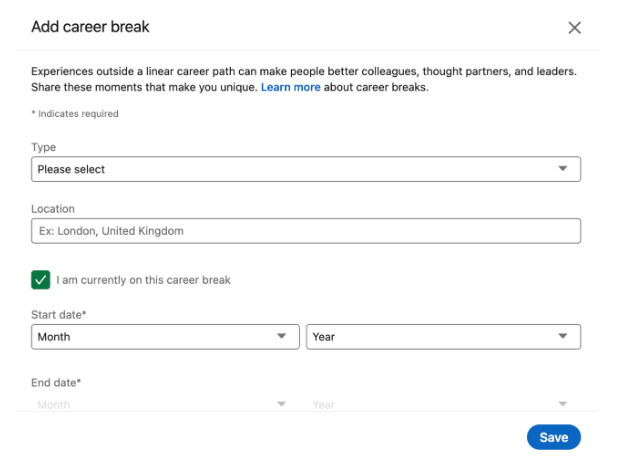 In March 2022, LinkedIn introduced a new Career Break feature that lets users present employment gaps in their work history. Here’s how to use it.
In March 2022, LinkedIn introduced a new Career Break feature that lets users present employment gaps in their work history. Here’s how to use it.
You might find yourself between jobs because that was what you wanted, and it was your own decision to take a break. Good for you.
But these days, with the world upside down because of COVID, there are many who suddenly found themselves at the wrong place at the wrong time.
Your company closed or you were laid-off?
 Their company closed, staff laid off for cost-saving reasons, or senior positions made redundant. Whatever the reason, you may now face a period where you wake up to job-hunting and no longer to a permanent job.
Their company closed, staff laid off for cost-saving reasons, or senior positions made redundant. Whatever the reason, you may now face a period where you wake up to job-hunting and no longer to a permanent job.
It’s understandable that some sort of panic sneaks into your life. Every day it feels like your confidence takes a beating and as time goes by it’s slowly disappearing. The stakes will feel high in particular if you support a family.
First advice: When you approach potential employers or executive search firms, do not come across as too desperate.
Do not stalk the hiring manager or recruiter with daily calls and emails. Do not suggest that you are prepared to take a huge salary drop just to get something. Believe me, this is a huge turnoff.
Instead, focus on presenting yourself as you would have done when you were still working. Leave out personal details.
Second advice: Yes, true. I found myself between jobs 20 years ago and found solace in reading several books. The two I still fondly recall are still available:
- John Gray: Mars and Venus Starting Over
- Richard Bolles: What Color Is Your Parachute
What to write if you have months between two jobs
Let’s come back to how you present yourself in a Resume and on LinkedIn when you have months or years between two jobs.
First of all, having gaps between jobs are no longer unusual. Gone are the days where you joined a company around the age of 20 and worked through to retirement at 65 – having increasingly bigger and bigger jobs.
In fact, many recruiters will not even notice a gap. By moving the work period from either the left margin or the right margin into the middle and immediately after your title or company, using a font size smaller than the other words and using a gray colour, will almost make it disappear and not attract the same attention if you use any of the margins.
Stop using date and month when you present the employment period. Instead of February 2017 to January 2020, write 2017 to 2020.
Say this is your three most recent jobs:
- ABC Company | July 2011 to August 2015
- DEF Company | October 2015 to July 2016
- HIK Company | August 2016 – present
Leave out the DEF of 10 months. This is how you write it in the Resume and on LinkedIn:
- ABC Company | 2011 to 2015
- HIK Company | 2016 – present
If you took time off to get your MBA studying full time, if you were a “professional” mom to your children for a while, if you volunteered to work for an NGO, if you worked on ad-hoc projects to help a friend or your children’s school, if you were doing Pro Bono jobs, if you can call yourself an independent consultant because you gave advice to someone – these are all good reasons for a gap.
Stay cool, a professional recruiter has bigger things to look at in your professional career.
If the interviewer grills you about your employment gap or seems to be trying to pry additional information from you, that’s a red flag.
Reconsider if this is the type of work culture and individual you want to work with.
Companies should be looking at your resume to see your experience, not scrutinize your career timeline.
Of course, looking to see tenure and promotions within a company is key information for recruiters, but getting hung up on dates or excessively analyzing gaps in employment is a bad sign.
New LinkedIn feature: Career Break
 Did you take time off to get your MBA by studying full-time, were a “professional” mom to your children for a while?
Did you take time off to get your MBA by studying full-time, were a “professional” mom to your children for a while?
Did you volunteer to work for an NGO, did you work on ad-hoc projects to help a friend or your children’s school, were you doing Pro Bono jobs, or would it be fair to call yourself an independent consultant because you gave advice to someone?
In a LinkedIn 2022 survey of 23,000 global workers, 62% of employees said they had taken a break at some point in their professional careers.
These are all good reasons for a gap.
In March 2022, LinkedIn introduced a new Career Break feature that lets users present employment gaps in their work history. Here’s how to use it.
The long list of options to choose from looks like this.
- Bereavement
- Career Transition
- Caregiving
- Full-time parenting
- Gap year
- Layoff/position eliminated
- Health and well-being
- Personal goal pursuit
- Professional development
- Relocation
- Retirement
- Travel
- Voluntary work
How to add Career Break in LinkedIn
To add the Career Break to your Work Experience, take these few easy steps. And note that adding a Career Break does not notify your network.
- From your LinkedIn profile, select the “Add profile section” button from just below your name and headline.
- Select “Add career break” from the dropdown menu.
- In the new window, fill in the required information.
- Save to add Career Break to your work experience.

